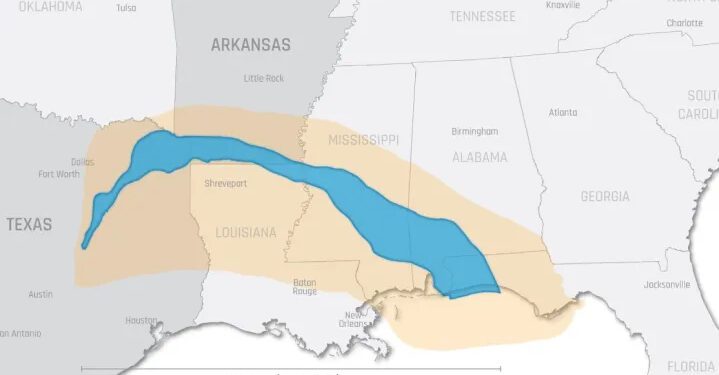The United States Geological Survey announced Monday that there might be between 5 million to 19 million tons of lithium reserves in underground brine in the Smackover Formation in south Arkansas.
“If commercially recoverable, the amount of lithium present would meet projected 2030 world demand for lithium in car batteries 9 times over,” the USGS study said.
The USGS, in partnership with the Arkansas Department of Energy and Environment’s Office of the State Geologist, used a “novel methodology” involving water testing and artificial intelligence to determine the amount of lithium that could possibly be extracted from brine reservoirs in a geological region known as the Smackover Formation, which covers south Arkansas and parts of Texas, Louisiana, Mississippi, Alabama and Florida.
From the USGS:
“Our research was able to estimate total lithium present in the southwestern portion of the Smackover in Arkansas for the first time. We estimate there is enough dissolved lithium present in that region to replace U.S. imports of lithium and more. It is important to caution that these estimates are an in-place assessment. We have not estimated what is technically recoverable based on newer methods to extract lithium from brines,” said Katherine Knierim, a hydrologist and the study’s principal researcher.
The USGS predictive model provides the first estimate of total lithium present in Smackover Formation brines in southern Arkansas, using machine learning, which is a type of artificial intelligence. Samples from Arkansas were analyzed by the USGS Brine Research Instrumentation and Experimental lab in Reston, Virginia, and then compared with data from historic samples within the USGS Produced Waters Database of water from hydrocarbon production.
The machine learning model was then used to combine lithium concentrations in brines with geological data to create maps that predict total lithium concentrations across the region, even in areas lacking lithium samples.
Five companies have been working to start the lithium extraction business in south Arkansas. Those companies, including ExxonMobil and Standard Lithium, have been locked in an ongoing dispute with landowners over how much the landowners will be paid for mineral rights.
During a conference last week in Little Rock, a representative from Standard Lithium said that if the landowners demand a royalty rate that is too high, the Arkansas lithium business will never be able to compete globally, if it even gets off the ground in the first place.
A nascent industry in the U.S., the lithium production and processing business is currently dominated by other countries, namely China, Chile and Australia.
Lithium is a key component in batteries used in electric vehicles and electronics and other devices, and prices of the metal are projected to increase over the long-term. However, the EV industry is volatile, and lithium prices have dropped globally in recent months due to a glut on commodity markets. Price swings may impact the financial viability of new extraction and processing projects around the world, including the U.S.
The New York Times reported Monday that ExxonMobil recently “drilled exploratory wells in Arkansas and was evaluating whether it could extract lithium in a cost-competitive way.”
Dan Ammann, president of ExxonMobil’s Low Carbon Solutions business told The New York Times: “We know we have an attractive resource. We’re working on understanding that cost equation, understanding the supply-and-demand picture.”
The full USGS study can be found here.
Source link : http://www.bing.com/news/apiclick.aspx?ref=FexRss&aid=&tid=6716e5e2208d42988605a88274806da1&url=https%3A%2F%2Farktimes.com%2Farkansas-blog%2F2024%2F10%2F21%2Fsouth-arkansas-could-have-enough-lithium-to-meet-projected-2030-global-demand&c=432189886393846822&mkt=en-us
Author :
Publish date : 2024-10-21 10:57:00
Copyright for syndicated content belongs to the linked Source.









